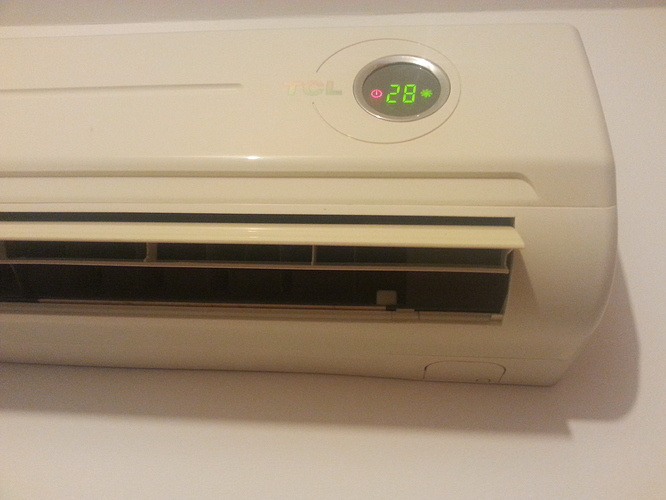I have a similar project. The simplest way for me was to add a temp sensor (ds18b20) next to IR sensor. Every time I open Blynk, the temp sensor shows me the temperature, thus I know if the AC is on or off.
Doesn’t room temperature affect the DS18B20 reading from the LED of the IR sensor?
What do you mean? Ds18b20 reads the temperature from room where the AC is and arduino sends signals through IR sensors to AC unit. Moreover, I can set a threshold of desired temperature and arduino starts or stops the unit.
@Gicus that will not work for @Pavlo’s requirement. I thought you were checking the temperature of the LED on the ac unit to see if the ac unit was on or off.
He doesn’t want to know how to turn it on and off, he wants to know if his wife has turned it on or off via the handset rather than Blynk.
He can use room’s temperature as a kind of feedback from AC unit.
Not really as room temperatures go up and down without the aircon being on.
Ok. That was my story, if outside is hot and Blynk shows me 22 °C inside then I surely know that the unit runs.
If outside is 30 and inside is 30 has Pavel’s wife turned the air con on or not? Answer, you have no idea.
In my opinion it is off, otherwise the AC unit is inefficient (I’m joking).
Another idea: put an IR receiver next to AC unit. You already know the codes for turning on and off and based on that you could set a Blynk led or other widget to show you what code was sent.
Hey, would it work if said temperature sensor was placed right in the middle of the stream of cold air?
For instance, if I measure the temperature right outside my AC vent, it reads like 10 celsius. If I measure the temperature of the room (far away from the cold stream of air of my AC) I would measure 22 celsius (for example).
With this is mind, placing the sensor right in the middle of the stream of cold air one would be able to detect if the AC is on or not, since generally speaking my room never reaches 10 celsius…
would this work?
Gustavo.
@gusgonnet not viable due to the very long powering up and down time of the compressor to give the 10 C.
Hey there!
Did someone say something regarding the use of a “Piezo element” to detect the vibration of this huge machine??
https://www.arduino.cc/en/Tutorial/Knock
Kind regards!!
@Pavlo thinking about how air con units generally work does it really matter what your wife does?
The remote control sends a different signal for on and off so if your Photon detects that it should be on it would send the ON signal, it is not a toggling feature that would turn off the device if your wife had already turned it on.
@psoro, if this was mission critical, which I’m not convinced it is, then the piezo would have the same problem as the 10 C air flow check i.e. compressor time before unit vibrates.
(P.S. received your DS18B20 probe today and it worked first time, thanks).
@Pavlo
I don’t know how accurate the colour readings are with CDS photocells but your Frigidaire unit appears to show the temperature in green like our TCL unit.
The benefit of the photocell detecting green is that when you power off the unit the green disappears immediately and vice versa for power on.
Colour detection with photocell instructable including sketch at http://www.instructables.com/id/Using-an-RGB-LED-to-Detect-Colours/?ALLSTEPS
Thanks everyone for great ideas. I think I’m going to use the current sensor since I wanted to play with them for a long time. I would also like to measure the power consumption.
My plan is to use a power extension cord for 3-5 sockets and place either photon or ESP inside the enclosure. Do you guys think interference would be a problem?
I really liked the photocell hack, but last time my wife was cleaning up and completely broke the IR LED… So it’s not an option 
@costas btw this stupid machine uses same code for on and off. Which drives me crazy.
That would drive me nuts (a close cousin to crazy)!
I have an ESP within a 5 socket extension and it works fine. I think the main thing to worry about with these chips is interference from DC sources like transformers and such. It was quite a job to get everything stuffed inside, so beware of isolation. 220v is not something to be messed with (or 110 for that matter). We’d like our Pavel not electrocuted, lol.
Both AC/DC will generate magnetic/electric field that might cause interference. You have to worry about it if they are powerful enough (high voltage/current) or if your equipment is really sensible.
Just don’t use metallic enclosure because of the way waves propagate on them.
in fact any air conditioner will have some certain problems with power supply
Hi @Muller21QQQ, first of all, welcome to this community and, after that, please, check date for last reply, you are 3 years late! 
